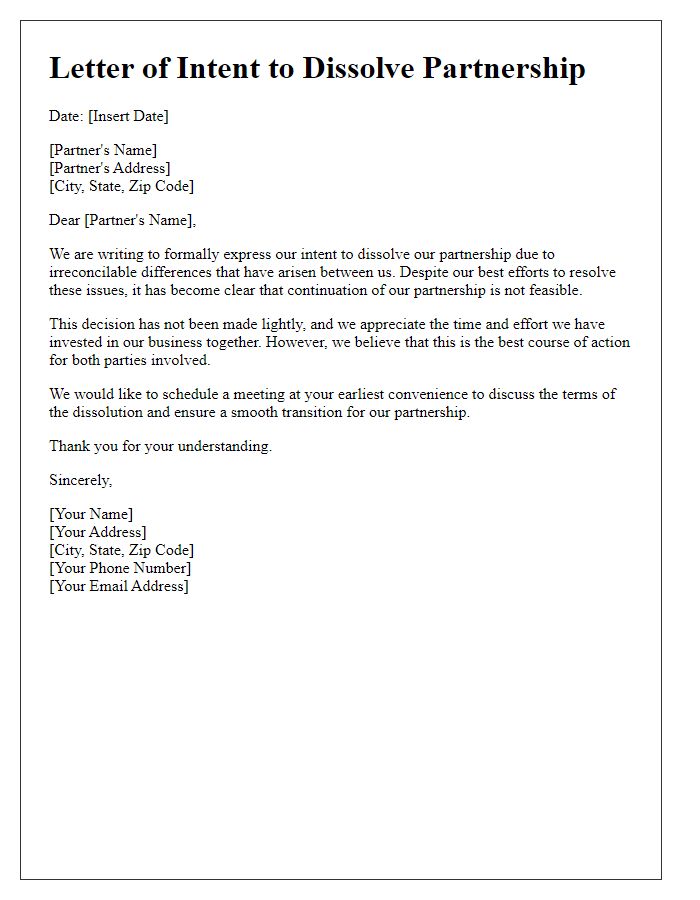Navigating the complexities of ending a partnership due to irreconcilable differences can be a sensitive topic, yet it's essential for maintaining respect and clarity. Whether it's a business venture or personal collaboration, articulating your intentions in a compassionate and direct manner can significantly ease the transition. In this article, we'll explore the right approach to drafting a letter that communicates your decision while preserving the dignity of all parties involved. So, if you're ready to learn how to express your thoughts with grace, keep reading!

Clear Statement of Intent
The dissolution of partnerships often arises from irreconcilable differences, highlighting the need for clear communication. A partnership agreement may specify conditions, but emotional factors play a crucial role in the process. Seeking mediation can facilitate negotiations, offering structured dialogue. Accurate documentation, such as financial statements, helps clarify asset distribution. Legal counsel is vital to navigate state-specific laws during dissolution, particularly in jurisdictions like California, which has specific procedures. It is essential for partners to remain transparent about intentions and the rationale behind the decision, ensuring a respectful and orderly dissolution process.
Specific Reasons for Differences
Irreconcilable differences in partnerships often arise from conflicting visions, differing values, financial disagreements, or management philosophies. Specific reasons for these differences can include divergent business goals that affect long-term strategy, such as expanding into new markets or focusing on product development. Cultural discrepancies, such as differing attitudes towards risk management or employee relations, can create tension. Varied financial expectations, like revenue sharing or investment strategies, lead to disputes. Additionally, contrasting managerial styles, where one partner prefers a hands-on approach while another champions autonomy, can exacerbate conflicts. Such dissonances, when unresolvable, illustrate the complexities of partnership dynamics.
Professional Tone and Language
Disagreements in partnerships can lead to irreconcilable differences, affecting business operations and relationships. Significant disputes may arise from diverging visions and strategies, financial discrepancies, or misaligned values. In a partnership defined by such challenges, the need for formal communication becomes essential. Addressing concerns succinctly can facilitate a more amicable resolution. Detailed documentation of the partnership's trajectory, including milestones, financial reports, and communication history, may provide essential context for discussions. Clarity on mutual interests and goals is crucial to navigate this delicate situation. A professional approach can foster constructive dialogue, potentially uncovering renegotiation opportunities or a smooth dissolution process. Clear timelines for responses and future discussions should also be established to maintain a respectful and organized dialogue.
Details of Transition Plan
The transition plan during the dissolution of a partnership due to irreconcilable differences encompasses several critical steps aimed at ensuring a smooth separation. Identification of assets includes tangible items such as real estate located at 123 Main Street, valued at $500,000, and intangible assets like trademark registrations, influencing market presence. Liabilities must also be clearly outlined, such as outstanding loans totaling $150,000 to the National Bank, creating a burden on the partnership. A timeline for the transition, spanning six months, details crucial milestones including the distribution of assets by December 1, 2023, and finalization of legal documents by November 15, 2023. Clients must be informed promptly, ideally by October 15, 2023, detailing changes in service providers to maintain trust. A communication strategy involving scheduled meetings and written notifications will engage stakeholders throughout the process. The appointment of an independent mediator, specialized in partnership disputes, for facilitating negotiations will aid in resolving any outstanding issues effectively. Regular progress updates aim to minimize uncertainty, preparing all parties for an amicable transition.
Contact Information for Follow-up
Irreconcilable differences in business partnerships can lead to significant challenges, affecting profitability and workplace morale. Clear communication channels and structured follow-up processes are essential. Establish a dedicated contact person, such as a partnership resolution manager, to handle ongoing discussions and document all communications thoroughly. Maintaining contact information for all partners involved, ideally on a shared digital platform like Google Sheets, ensures transparency and accountability. Proper record-keeping of emails, phone numbers, and any communication history can prevent misunderstandings. Utilizing services like Zoom or Microsoft Teams for virtual meetings can facilitate easier dialogue, especially for geographically dispersed partners, keeping discussions constructive and focused on resolution.
Letter Template For Irreconcilable Differences Partnership Samples
Letter template of notification for ending partnership from irreconcilable differences.

Letter template of formal separation based on irreconcilable differences.

Letter template of partnership termination due to irreconcilable differences.

Letter template of mutual agreement on partnership dissolution from irreconcilable differences.

Letter template of intent to dissolve partnership over irreconcilable differences.

Letter template of partnership breakup citing irreconcilable differences.

Letter template of exit notice due to irreconcilable differences in partnership.

Letter template of amicable dissolution stemming from irreconcilable differences.






Comments